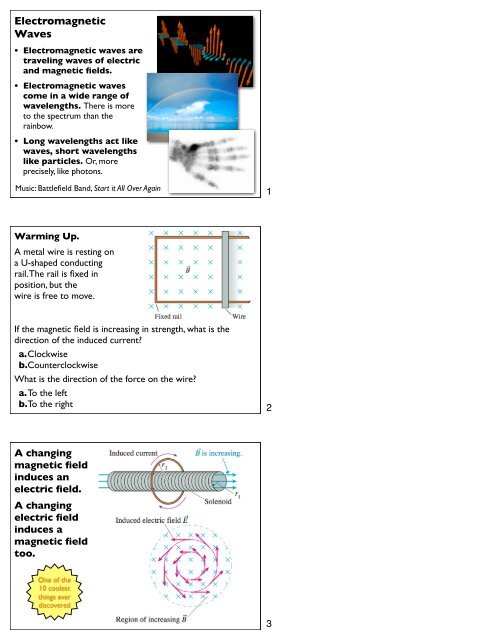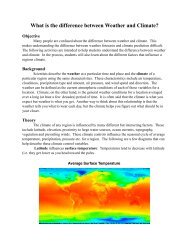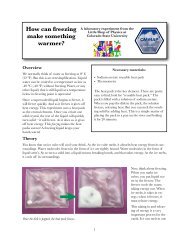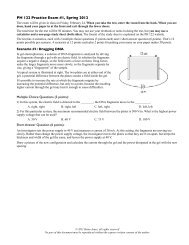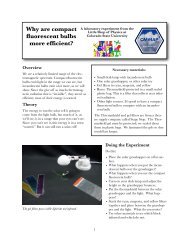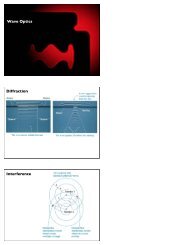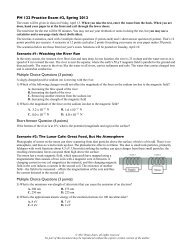Electromagnetic Waves Slides - Little Shop of Physics
Electromagnetic Waves Slides - Little Shop of Physics
Electromagnetic Waves Slides - Little Shop of Physics
Create successful ePaper yourself
Turn your PDF publications into a flip-book with our unique Google optimized e-Paper software.
<strong>Electromagnetic</strong><br />
<strong>Waves</strong><br />
• <strong>Electromagnetic</strong> waves are<br />
traveling waves <strong>of</strong> electric<br />
and magnetic fields.<br />
• <strong>Electromagnetic</strong> waves<br />
come in a wide range <strong>of</strong><br />
wavelengths. There is more<br />
to the spectrum than the<br />
rainbow.<br />
• Long wavelengths act like<br />
waves, short wavelengths<br />
like particles. Or, more<br />
precisely, like photons.<br />
Music: Battlefield Band, Start it All Over Again<br />
Warming Up.<br />
A metal wire is resting on<br />
a U-shaped conducting<br />
rail. The rail is fixed in<br />
position, but the<br />
wire is free to move.<br />
If the magnetic field is increasing in strength, what is the<br />
direction <strong>of</strong> the induced current?<br />
a.Clockwise<br />
b.Counterclockwise<br />
What is the direction <strong>of</strong> the force on the wire?<br />
a.To the left<br />
b.To the right<br />
A changing<br />
magnetic field<br />
induces an<br />
electric field.<br />
A changing<br />
electric field<br />
induces a<br />
magnetic field<br />
too.<br />
One <strong>of</strong> the<br />
10 coolest<br />
things ever<br />
discovered<br />
1<br />
2<br />
3
The Inductor<br />
L is the<br />
inductance;<br />
the unit is the<br />
Henry. (H)<br />
LC<br />
Circuits<br />
Tuned Circuits<br />
4<br />
5<br />
6
Unifying Electricity and Magnetism<br />
∇ ⋅ E = ρ<br />
ε 0<br />
∇ ⋅ B = 0<br />
∇ × E = − ∂ B<br />
∂t<br />
∇ × B = µ 0<br />
j + µ0ε 0<br />
The electromagnetic pulse.<br />
An accelerated charge emits a pulse <strong>of</strong> electric and<br />
magnetic fields. This pulse travels through space.<br />
Maxwell’s equations say the speed should be:<br />
1<br />
v = = 3.00 × 10<br />
ε0µ 0<br />
8 m/s<br />
The electromagnetic wave.<br />
An oscillating charge will emit an electromagnetic wave.<br />
It’s a wave <strong>of</strong> electric and magnetic fields.<br />
∂ E<br />
∂t<br />
7<br />
8<br />
9
FM vs. AM<br />
An FM station transmits at 100 MHz, corresponding to a<br />
wavelength <strong>of</strong> 3.0 m.<br />
An AM station transmits at 1000 kHz, which is 1.0 MHz.<br />
What is the corresponding wavelength?<br />
c = f λ<br />
FM: Pick up electric field<br />
FM & AM Radio<br />
1<br />
4 λ<br />
Helpful Relationships<br />
AM: Pick up magnetic field<br />
E = hf = hc<br />
λ<br />
h = 4.14 × 10 −15 eVis<br />
E (in eV) =<br />
1240<br />
λ (in nm)<br />
13<br />
14<br />
15
Atomic Energies<br />
Red vs. Blue?<br />
A red pen laser emits light<br />
<strong>of</strong> wavelength 670 nm.<br />
A blue pen laser emits light<br />
<strong>of</strong> wavelength 470 nm.<br />
Which has a higher photon energy, the red or the blue?<br />
The<br />
<strong>Electromagnetic</strong><br />
Spectrum<br />
Particle-y<br />
Depends<br />
Wave-ish<br />
16<br />
17<br />
18
The <strong>Electromagnetic</strong> Spectrum<br />
Wave Wavelength Frequency<br />
FM Radio<br />
Microwave<br />
Far IR<br />
Visible<br />
Ultraviolet<br />
10 µm<br />
500 nm<br />
290 nm<br />
The<br />
<strong>Electromagnetic</strong><br />
Spectrum<br />
The<br />
<strong>Electromagnetic</strong><br />
Spectrum<br />
100 MHz<br />
1.9 GHz<br />
Particle-y<br />
Depends<br />
Wave-ish<br />
Photon<br />
energy<br />
19<br />
20<br />
21
Basic Relationships<br />
The speed <strong>of</strong> electromagnetic waves<br />
A. depends on the wavelength<br />
B. depends on the photon energy<br />
C. is the same as the speed <strong>of</strong> sound<br />
D. is the same for all waves regardless <strong>of</strong> wavelength<br />
Basic Relationships<br />
A typical analog cell phone has a frequency <strong>of</strong> 850 MHz; a<br />
digital phone a frequency <strong>of</strong> 1950 MHz. Compared to the<br />
signal from an analog cell phone, the digital signal has<br />
! A. ! longer wavelength and lower photon energy<br />
! B. ! longer wavelength and higher photon energy<br />
! C. ! shorter wavelength and lower photon energy<br />
! D. ! shorter wavelength and higher photon energy<br />
Basic Relationships<br />
A radio tower emits two 50 W signals, one an AM signal<br />
at a frequency <strong>of</strong> 850 kHz, one an FM signal at a<br />
frequency <strong>of</strong> 85 MHz. Which signal has more photons per<br />
second? Explain.<br />
! A. ! The AM signal has more photons per second.<br />
! B. ! The FM signal has more photons per second.<br />
! C. ! Both signals have the same photons per second.<br />
22<br />
23<br />
24
Intensity<br />
From<br />
Chapter<br />
15<br />
Intensity is<br />
a ratio <strong>of</strong><br />
power to<br />
area:<br />
I = P<br />
a<br />
My laser pointer has a total output power <strong>of</strong> about 1.0<br />
mW. When I shine it on the screen, it spreads out to<br />
make a spot about 1.0 mm in diameter. What is the<br />
intensity <strong>of</strong> the light in this spot?<br />
How does this compare to the intensity <strong>of</strong> sunlight on<br />
the ground at high noon on a summer day (which is<br />
approximately 1100 W/m 2 )?<br />
Energy and Field Strength<br />
E 0 =<br />
2I<br />
cε 0<br />
B 0 = E 0<br />
c<br />
Intensity and Field Strength<br />
E 0 = cB 0<br />
The laser pointer from the previous problem has an<br />
intensity <strong>of</strong> 1300 W/m 2 .<br />
What electric and magnetic field strengths does this<br />
intensity correspond to?<br />
25<br />
26<br />
27
Intensity Variation for Spherical Wave<br />
Polarization<br />
Navigating By The Sky<br />
Polarization <strong>of</strong> skylight<br />
I = P source<br />
4πr 2<br />
Bee eyes<br />
detect<br />
polarization<br />
28<br />
29<br />
30
The Microwave Oven<br />
Inside the cavity <strong>of</strong> a microwave oven, the 2.4 GHz<br />
electromagnetic waves have an intensity <strong>of</strong> 5.0 kW/m 2 .<br />
a. What is the strength <strong>of</strong> the electric field?<br />
b. The magnetic field?<br />
A digital cell phone emits a 1.9 GHz<br />
electromagnetic wave with total power<br />
0.60 W.<br />
• At a cell phone tower 2.0 km away,<br />
what is the intensity <strong>of</strong> the wave?<br />
(Assume that the wave spreads out<br />
uniformly in all directions.)<br />
• What are the electric and magnetic<br />
field strengths at this distance?<br />
Biological Effects <strong>of</strong> EM Radiation<br />
Long wavelength<br />
Short wavelength<br />
Wave-ish Particle-y<br />
31<br />
32<br />
33
What are the photon energies corresponding<br />
to the following wavelengths?<br />
a. Near IR, 1000 nm<br />
b. Far red end <strong>of</strong> the spectrum, 750 nm<br />
c. Far blue end <strong>of</strong> the spectrum, 400 nm<br />
d. Near UV, 290 nm<br />
Atomic Energies<br />
E (in eV) =<br />
Atomic Radiation<br />
Visible spectrum:<br />
Approx. 400 - 750 nm<br />
1240<br />
λ (in nm)<br />
34<br />
35<br />
36
Visible Light, Near IR and UV<br />
3 different cones<br />
tuned to different<br />
photon energies<br />
The band gap <strong>of</strong> the silicon used to make the CCD<br />
detector in a black and white security camera is 1.12 eV.<br />
Photons with energy greater than this will be detected.<br />
• What wavelength does this correspond to?<br />
• In what part <strong>of</strong> the spectrum is this?<br />
You Look Positively Radiant<br />
A typical human has a surface area <strong>of</strong> about 1.8 m 2 . All<br />
skin, regardless <strong>of</strong> color, has an emissivity <strong>of</strong> about e=0.97.<br />
How much power does a person’s body radiate at normal<br />
skin temperature? (About 33 °C, or 306 K)<br />
What is the peak wavelength <strong>of</strong> the emission?<br />
37<br />
38<br />
39
Pit Vipers 1600 cells<br />
100 Watts = 4 Watts?<br />
Raw Processed<br />
A typical incandescent lamp has a filament at a<br />
temperature <strong>of</strong> approximately 2500 °C.<br />
What is the peak wavelength <strong>of</strong> the emission?<br />
Short wavelength = high photon energy<br />
Germicidal lamps<br />
254 nm<br />
4.9 eV<br />
Tanning beds<br />
365 nm<br />
3.4 eV<br />
40<br />
41<br />
42
Creating X rays<br />
If an electron is accelerated through a 5.0 kV potential<br />
difference, what is the maximum photon energy <strong>of</strong> the<br />
resulting x ray? What is the wavelength?<br />
Using X rays<br />
43<br />
44


